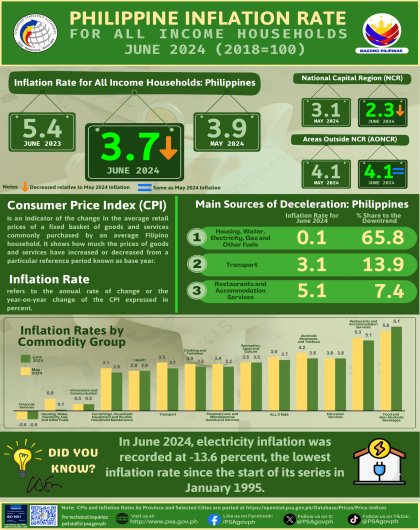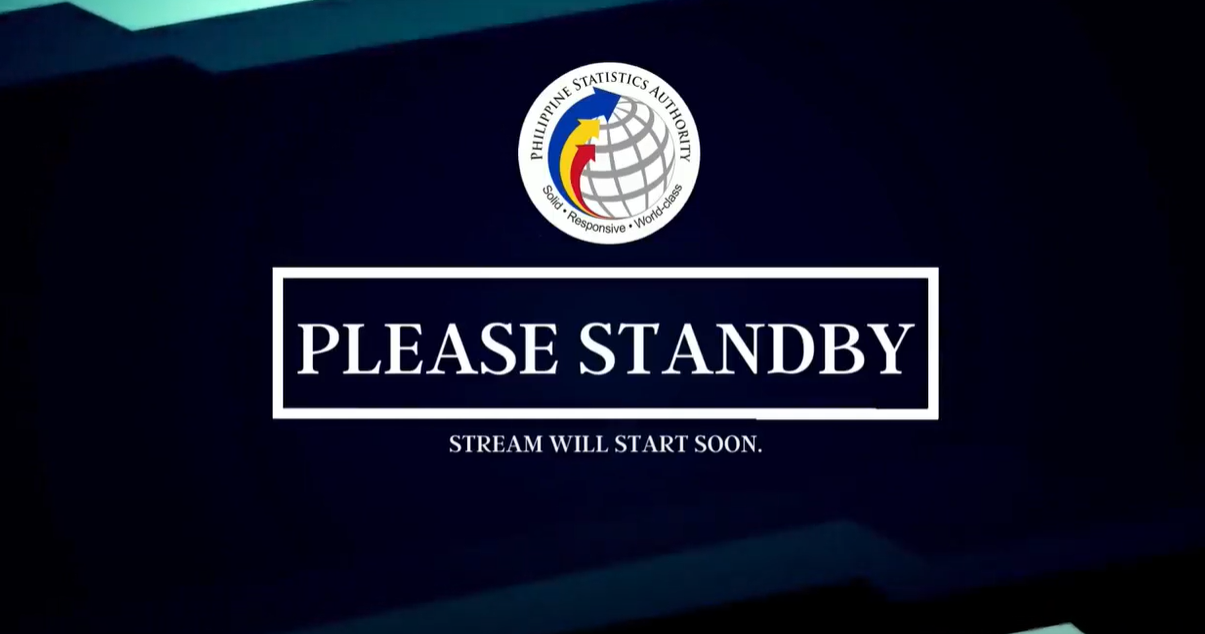Summary Inflation Report Consumer Price Index (2018=100): June 2024
YEAR-ON-YEAR
Philippines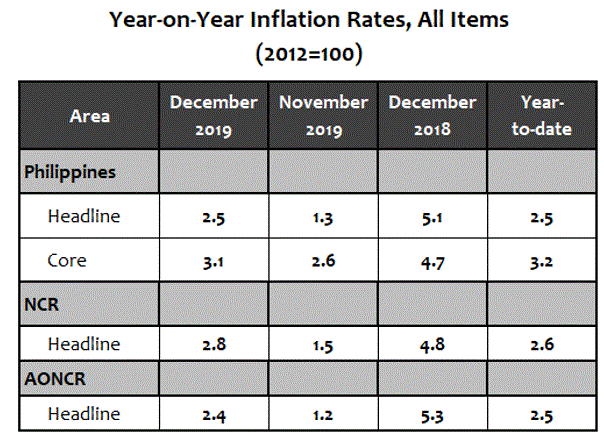
The country’s headline inflation increased further by 2.5 percent in December 2019. Inflation was observed at 1.3 percent in November 2019 and 5.1 percent in December 2018.
The uptrend in the inflation in December 2019 was mainly brought about by the 1.7 percent annual increment recorded in the heavily-weighted food and non-alcoholic beverages index. In the previous month, food and non-alcoholic beverages index registered an annual rate of zero percent.
Likewise, the annual change of the transport index picked up by 2.2 percent during the month, from 2.4 percent annual decline in November 2019. Moreover, higher annual increases were noticed in the indices of alcoholic beverages and tobacco at 18.4 percent; housing, water, electricity, gas, and other fuels, 1.9 percent; and furnishing, household equipment and routine maintenance of the house, 3.1 percent.
On the contrary, a slower annual mark-up of 2.9 percent during the month was noted in health index. The rest of the commodity groups retained their previous month’s annual rates (see Tables 3 and 4).
The annual average headline inflation of the country for the year 2019 slowed down to 2.5 percent from 5.2 percent in 2018.
Relative to their annual average 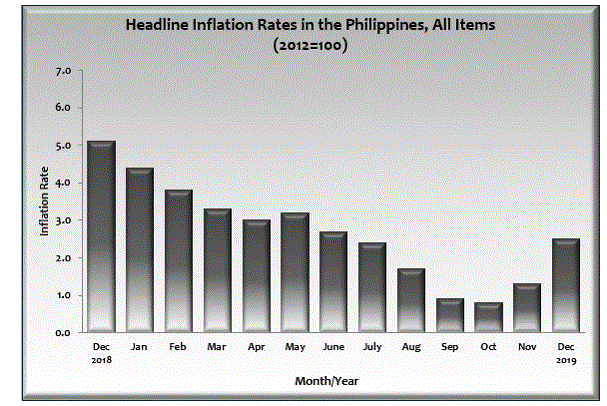 rates in 2018, the indices of the following commodity groups exhibited lower annual average increases in 2019:
rates in 2018, the indices of the following commodity groups exhibited lower annual average increases in 2019:
- Food and non-alcoholic beverages, 2.1%;
- Alcoholic beverages and tobacco, 12.8%;
- Housing, water, electricity, gas, and other fuels, 2.4%;
- Transport, 1.0%; and
- Restaurant and miscellaneous goods and services, 3.4%.
On the other hand, the annual average inflation rates were higher during the year in the indices of the following commodity groups:
- Clothing and footwear, 2.6%;
- Furnishing, household equipment and routine maintenance of the house, 3.2%;
- Health, 3.5%; and
- Recreation and culture, 2.5%.
Moreover, the annual average inflation of education index went up by 0.2 percent in 2019, from a 0.8 percent annual average decline in 2018. The communication index retained its previous year’s annual average rate of 0.3 percent (see Table 3).
Excluding selected food and energy items, core inflation escalated by 3.1 percent in December 2019. Core inflation was recorded at 2.6 percent in the previous month, while it was 4.7 percent in the same period of 2018.
The annual average core inflation during the year was 3.2 percent, from 4.2 percent in 2018 (see Table 9).
On an annual basis, the food index in the Philippines climbed by 1.7 percent in December 2019, after posting a 0.2 percent drop in the previous month. Inflation for food was observed at 6.3 percent in December 2018 (see Table 7).
Higher annual rates were noticed in the indices of the following food groups:
- Fish, 7.4%;
- Milk, cheese and egg, 3.3%;
- Vegetables, 8.2%; and
- Food products, not elsewhere classifed, 6.3%.
Slower annual hikes were registered in the indices of other cereals, flour, cereal preparation, bread, pasta and other bakery products at 2.6 percent; oils and fats, 0.5 percent; and fruits, 7.5 percent. Also, negative annual rates were observed in the indices of rice at 6.8 percent; corn, 1.5 percent; and sugar, jam, honey, chocolate and confectionery, 3.1 percent. Furthermore, annual movement in the index of meat remained at 3.2 percent (see Table 5).
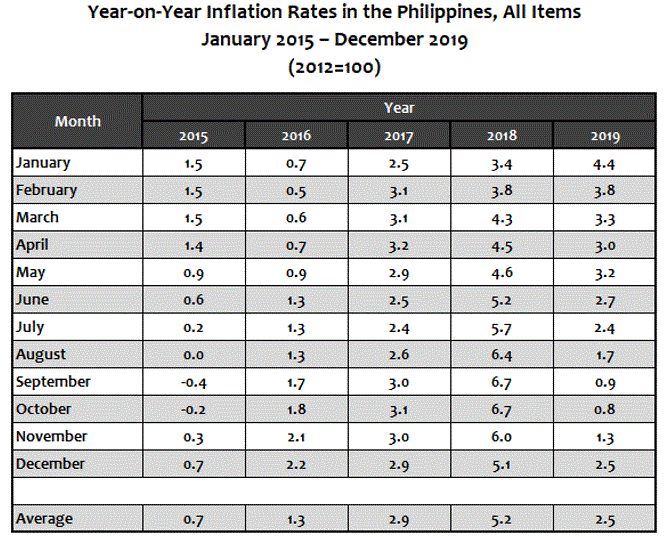
National Capital Region (NCR)
Similarly, inflation in NCR rose further by 2.8 percent in December 2019. Inflation in the area was posted at 1.5 percent in November 2019 and at 4.8 percent in the same month of the previous year.
Higher annual increases were noticed in the indices of eight out of 11 commodity groups during the month. Moreover, the annual rate of transport index went up by 0.8 percent in December from -4.4 percent in November. On the other hand, a slower annual gain of 1.0 percent was seen in the index of clothing and footwear and the same annual rate of 5.4 percent as of previous month was noted in the index of education (see Tables 3 and 4).
The annual average inflation in NCR eased to 2.6 percent in 2019, from 5.5 percent in 2018 (see Table 3).
Areas Outside NCR (AONCR)
On an annual basis, prices of consumer items in AONCR, likewise, accelerated further by 2.4 percent in December 2019. In the previous month, inflation in AONCR was registered at 1.2 percent and in December 2018, 5.3 percent.
Annual changes in the indices of food and non-alcoholic beverages picked up by 1.2 percent and transport, 2.7 percent in December 2019, from their respective previous month’s annual rates of -0.5 percent and -1.8 percent. In addition, higher annual hikes were observed in the indices of alcoholic beverages and tobacco at 19.5 percent; housing, water, electricity, gas, and other fuels, 2.2 percent; and furnishing, household equipment and routine maintenance of the house, 3.5 percent.
The rest of the commodity groups either had slower annual increments or retained their previous month’s annual rates (see Tables 3 and 4).
Inflation in Region II (Cagayan Valley) and Region IX (Zamboanga Peninsula) during the month went up by 1.6 percent and 1.2 percent, respectively, after exhibiting negative annual rates of 0.1 percent and 0.5 percent, respectively, in November 2019. All other regions in AONCR registered higher annual mark-ups during the period. The highest inflation among the regions in AONCR was seen in Region V (Bicol) at 3.3 percent, while the lowest was observed in Bangsamoro Autonomous Region in Muslim Mindanao (BARMM) at 0.8 percent (see Table 4).
The annual average inflation in AONCR decelerated to 2.5 percent in 2019, from 5.1 percent in 2018 (see Tables 3 and 4a).
Compared with their 2018 annual average rates, all regions in AONCR had lower annual average inflation in 2019. Region IX (Zamboanga Peninsula) posted the lowest annual average inflation during the year at 1.0 percent. On the other hand, MIMAROPA Region recorded the highest annual average inflation at 3.9 percent (see Table 4a).
Note: CPIs and inflation rates by province and selected cities are posted at the PSA website (http://openstat.psa.gov.ph/).
(Sgd) CLAIRE DENNIS S. MAPA, Ph.D.
Undersecretary
National Statistician and Civil Registrar General
See more at the CPI and Inflation Rate page.

